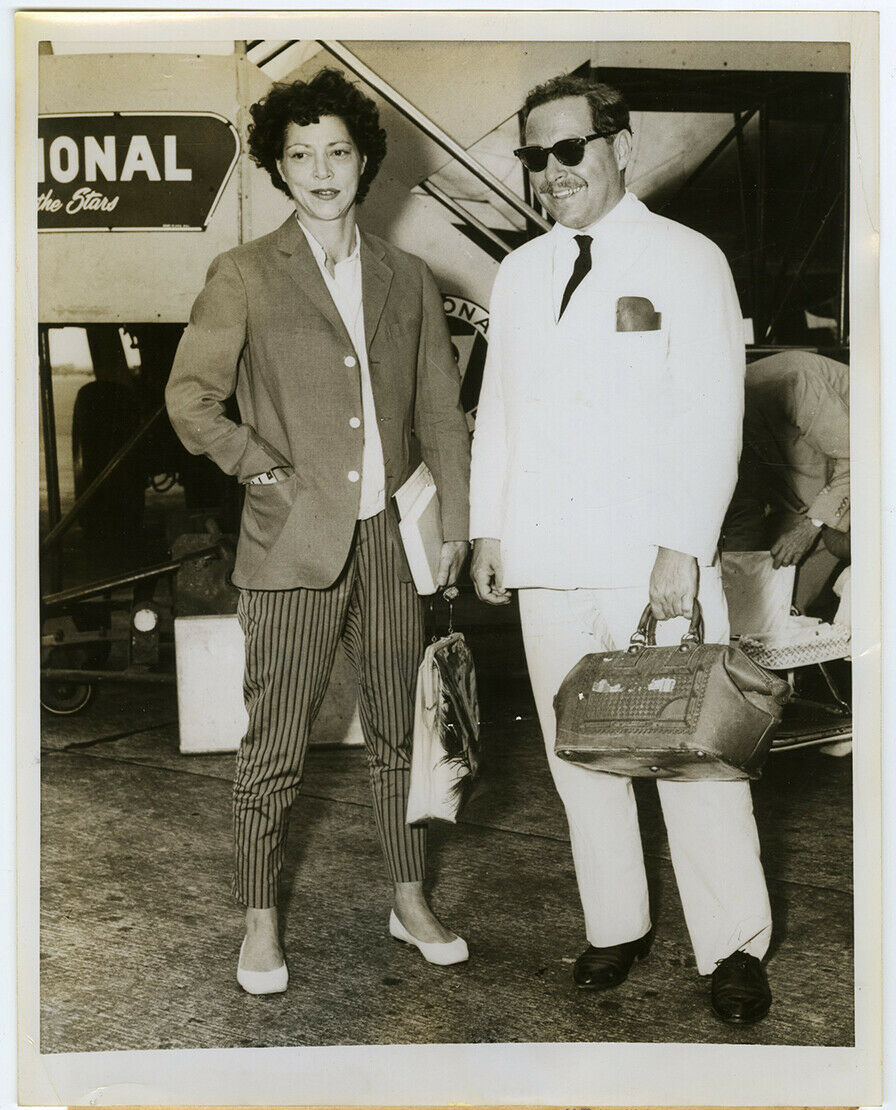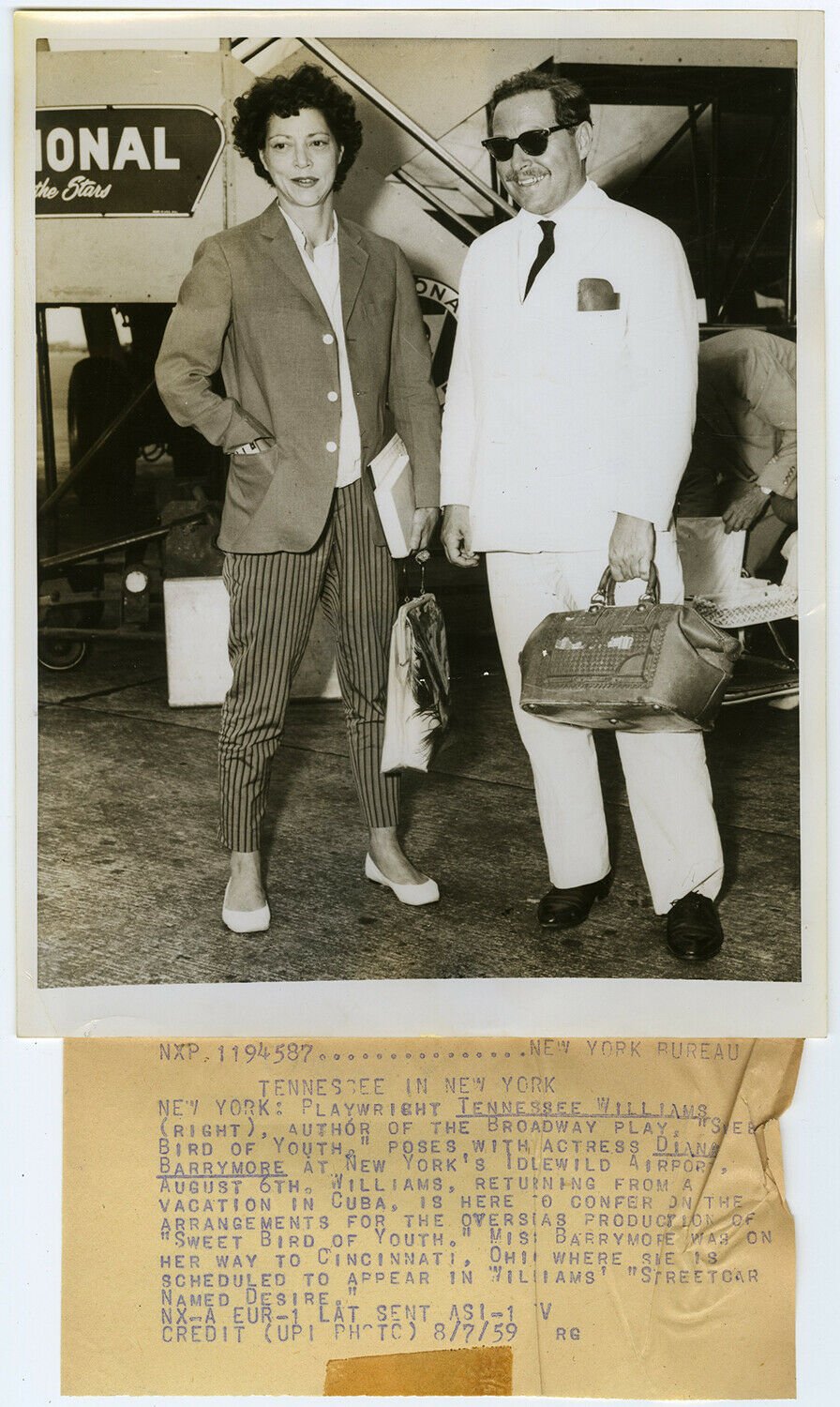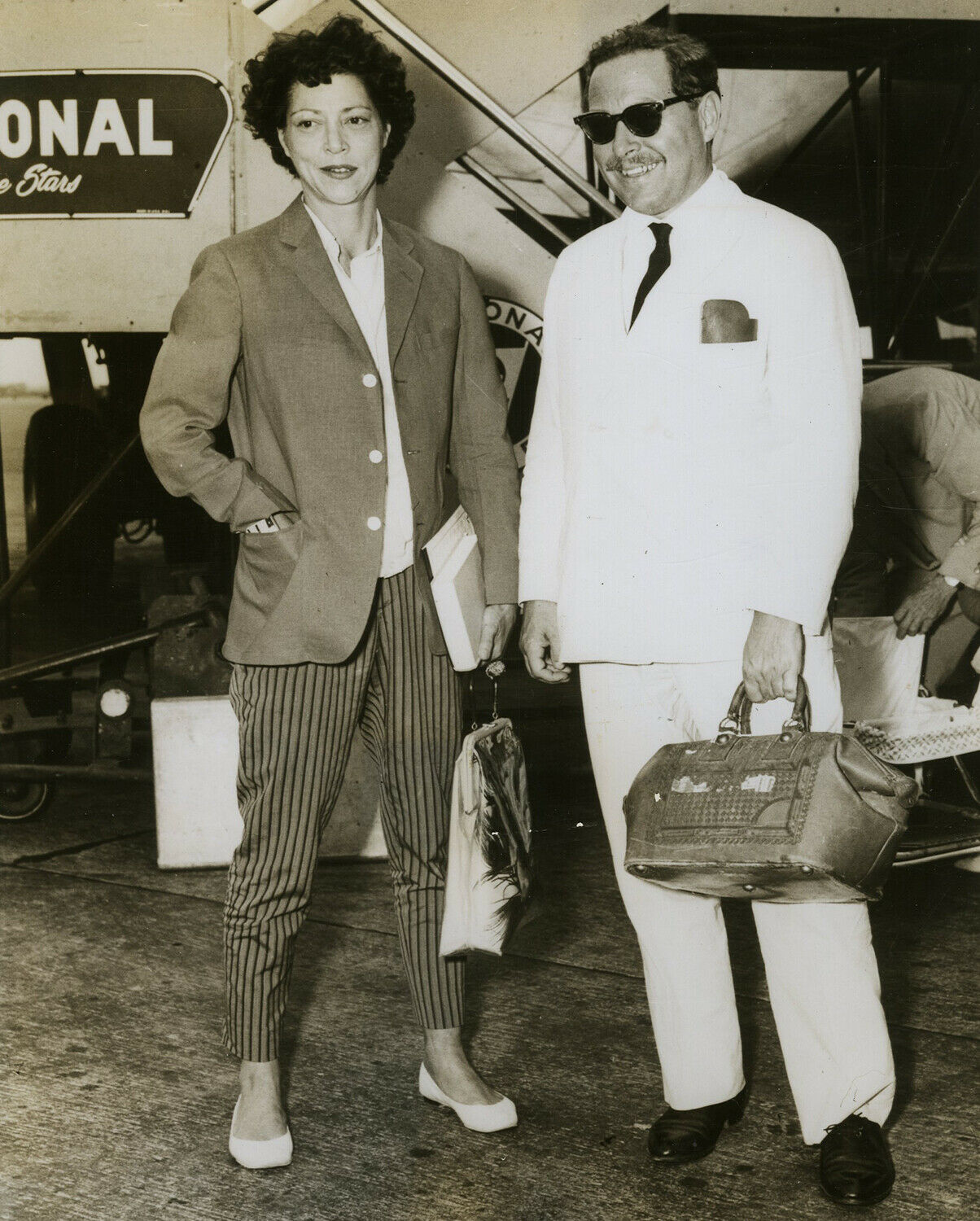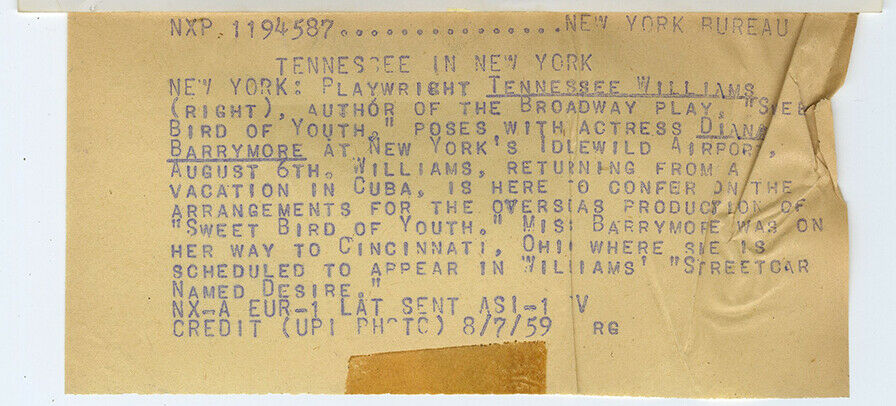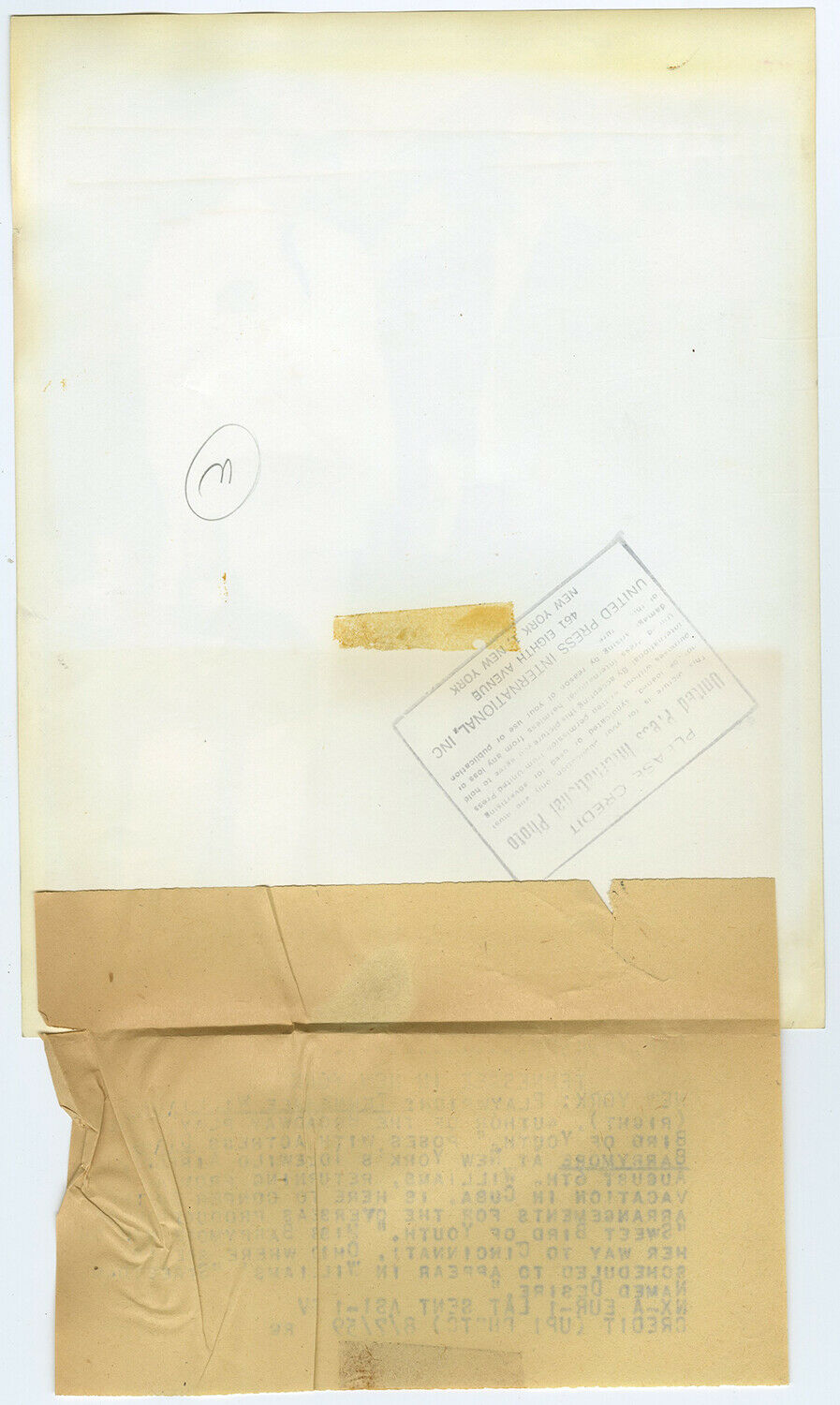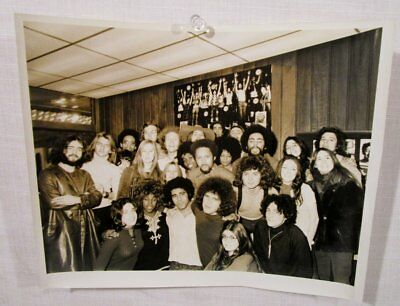-40%
Diana Barrymore & Tennessee Williams at Idlewild Airport 1959 Press Photograph
$ 3.95
- Description
- Size Guide
Description
ITEM: This is a vintage and original United Press International photograph dated August 7, 1959 and showing stage and screen actress (and daughter of legendary actor John Barrymore) Diana Barrymore posed next to playwright Tennessee Williams as they deplane at Idlewild Airport in New York. The press snipe on verso reads:TENNESSEE IN NEW YORK
NEW YORK: PLAYWRIGHT
TENNESSEE WILLIAMS
(RIGHT), AUTHOR OF THE BROADWAY PLAY, "SWEET BIRD OF YOUTH," POSES WITH ACTRESS
DIANA BARRYMORE
AT NEW YORK'S IDLEWILD AIRPORT, AUGUST 6TH. WILLIAMS, RETURNING FROM A VACATION IN CUBA, IS HERE TO CONFER ON THE ARRANGEMENTS FOR THE OVERSEAS PRODUCTION OF "SWEET BIRD OF YOUTH." MISS BARRYMORE WAS ON HER WAY TO CINCINNATI, OHIO WHERE SHE IS SCHEDULED TO APPEAR IN WILLIAMS' "STREETCAR NAMED DESIRE."
Photograph measures 7" x 9" on a glossy single weight paper stock with United Press International ink stamp and paper caption on verso.
Guaranteed to be 100% vintage and original from Grapefruit Moon Gallery.
More about Diana Barrymore:
"Too Much, Too Soon" was the story of Diana's life, and the title of her autobiography. Her father was stage and screen legend John Barrymore and her mother was Blanche Oelrichs (who wrote under the masculine pseudonym Michael Strange), who had just divorced Mr. Thomas and had 2 children (Leonard and Robin) from that marriage. Diana's parents got married on August 15, 1920, and Diana was born 7 months later, on March 3, 1921.
At age 6, Diana was attending school in Paris and rarely saw her father as he was romancing Dolores Costello (whom he'd later marry) and divorcing Diana's mother. Next year, she was back in USA and by 1929, her mom had married Harrison Tweed. By age 14, she had already spent a few years in boarding school so she saw little of her mother and years had gone by without her meeting her father.
In 1934, when her father did come for one rare visit, he took Diana and an older schoolmate friend of hers to dinner and a movie and he got drunk and hit on Diana's 17-year-old schoolmate. In rebellion against years of getting no attention from her parents, Diana attended a dance wearing a "lurid red satin dress with a plunging neckline and hardly any back," and a pair of borrowed high heels. She had decided to stop feeling miserable and stop being a victim of her parents who had ignored her her entire life.
By 1937, Diana was enrolled in the American Academy of Dramatic Art in New York and vacationing summers in Europe on her 0 a month allowance (a fortune in those days). In November 1938, David Selznick gave Diana a screen test for playing Scarlett O'Hara in "Gone With the Wind' and although she didn't get the part, the following year Diana was doing summer stock in Maine for a week. By 1940, her salary had increased to 0 per week when she appeared in "Outward Bound" in the Harris Theatre in Chicago, right next door to where John Barrymore was performing "My Dear Children" at the Selwyn Theatre, his first theatrical work in 15 years (he had exclusively made movies since 1925).
At 19 years of age, Diana made her Broadway debut playing Caroline Bronson in "Romantic Mr. Dickens." Later, helping the war effort, she also campaigned for "Bundles for Britain." In January 1942, Diana left the stage for Hollywood when producer Walter Wanger had promised to cast her in movies at ,000 a week, and she would appear in two of his films: Eagle Squadron (1942) with screen legend Robert Stack and later Ladies Courageous (1944). Actor Van Heflin proposed to Diana, and introduced her to producer Joe Pasternak, who had collaborated with director Henry Koster on many films; Koster was set to direct Between Us Girls (1942). Diana got the role, but not Van Heflin, two days later he married Frances Neal.
Diana visited the hospital the night her father died on May 29, 1942 (of cirrhosis of the liver, from decades of too much alcohol). She let years of pent-up emotions out when she wrote, "Damn mother for her indifference and disdain of me, and damn daddy for the crazy, mixed-up life he led."
Diana quickly married Bramwell Fletcher, who was 18 years older than her, on July 30, 1942 (they would divorce in 1947). Diana gave a standout performance in the starring role in the film noir classic Nightmare (1942) costarring Oscar-nominated veteran actor Brian Donlevy but problems started with the filming of Fired Wife (1943); even though her salary was now raised to ,000 per week, and Universal had advertised her as "1942's Most Sensational New Screen Personality"; it seemed it was all too much, too soon. The box office didn't deliver as they had counted on her Barrymore name so the studio had wanted to cash in on her instantly instead of grooming her for roles, and finding suitable projects. When Universal, clutching at straws, asked if she'd work with Abbott andCostello, Diana refused and was put on unpaid suspension. The suspension lasted 6 months and when Diana was cast in "Ladies Courageous" it was in a secondary role, the lead had been reassigned to Loretta Young.
December 1943, Diana and her husband headed back to New York and despite achieving some recognition in movies, her film career was over and Diana considered herself a has-been before her 23rd birthday. The couple took the Theatre Guild production of "Rebecca" on the road to Cleveland, Detroit, Pittsburgh, St. Louis, Cincinnati. By the summer of 1945, Diana returned to Hollywood she couldn't find any parts in movie but was instead offered ,000 a week to be on Jack Carson's NBC radio show. In 1947, Diana divorced her husband and married again on the rebound. This time it was to a John R. Howard who was a 6'2" tennis pro (5th ranked in the nation) whom Diana met and married (January 17, 1947), and divorced after living with him as man and wife for 6 months; he was 2 years younger than her. John was broke, sponged off Diana's money and got them both arrested one night in June in his hometown of Louisville, Kentucky for drunk driving and he'd assaulted the policemen. After only 6 months of marriage, Diana asked for a divorce but John would only agree to give it to her for a large sum of money. Diana refused to pay him and got the divorce after 3 years.
Diana went to Salem, MA, to do summer stock where the producer introduced her to actor Robert Wilcox, who would become husband number three. Wilcox had been in about 2 dozen B-movies, was 11 years older than Diana and was also a recovering alcoholic. They celebrated his release from the rehab clinic by drinking martinis. Summer stock became a winter tour in Atlanta, with Diana earning 0 a week and Wilcox 0 but Wilcox drank so heavily that soon nobody wanted to hire him but were forced to retain him as Diana refused to act without him. After summer stock in 1948, they returned to New York where the jobs soon ran out and they were forced to live on the trust fund John Barrymore had set up for her, becoming even more broke by the minute.
Early in 1950, CBS offered Diana a new opportunity: television. They offered her a live talk show, "The Diana Barrymore Show" at 11:00 p.m., and had guests like Earl "the Pearl" Wilson lined up. Diana showed up the first night, too drunk to work and the show was canceled before it aired. (To make matters worse, the show became "The Faye Emerson Show" which launched the former movie actress' television career into almost a dozen TV series).
When the FBI threw husband number two in jail (for white slavery), he no longer contested the divorce and Diana married Robert Wilcox on October 17, 1950 but her hopeful new start would soon come crashing down with the year ending with Diana's mother's death on November 5 1950. As the year 1951 started, Diana was at an all-time low point, she'd been drinking steadily for weeks, got the DTs and had gone through all her money (0,000 from her Hollywood earnings, and almost ,000 she'd inherited when her half-brother Robin had died). Diana pawned all her jewelry (diamond bracelets, pins, etc.) and took a job in Vaudeville which was considered demeaning but where she was at least earning a weekly salary again.
Rather than face humiliation in New York ("a Barrymore following a juggling act!"), Diana and Robert got booked for 3 weeks in the Celebrity Club in Sydney, Australia in the autumn of 1951--and stayed in Australia for 6 months, mainly doing stage performances at the Princess Theatre in Melbourne. Whereas she'd been shunned in New York, she was a big celebrity in Australia, for a while but Diana's drinking got her in trouble, again and even got her fired for her drinking in Brisbane, while booked into a vaudeville house with a girlie show called "the Nudie-Cuties." By March 1952, Diana and Robert were working in half empty houses in Tasmania.
Back in Hollywood later that year, they were so flat broke they got locked out of their hotel room because the rent was 2 weeks overdue; Diana mooched money from old friends like Tyrone Powers. In November 1952 came the shocking news that her late mother's estate, the once Barrymore millions, came to a mere ,000-- decades of lavish spending had spent it all. Diana and Robert tried to get help at an Alcoholics Anonymous meeting; however, they "fortified" themselves with drinks before the meeting, and made straight for a bar after it was over. Wilcox never worked, he just sat around the hotel room all day getting drunk, and sponging off Diana. She, in turn, started a love affair with Tom Farrell. Before it was all over, Robert had cracked both their skulls, leaving them bloodied where Diana needed stitches from a doctor, and then announcing she was divorcing Robert. Even though Tom Farrell had been "the other man" only a few weeks before, when Tom spotted Diana having a drink with an old friend, he went berserk. In their hotel room, in a jealous rage, he beat Diana to a bloody pulp, breaking her nose while he hit her with fists until she fell, and then kicking her repeatedly when she was on the floor. This would be the second time in such a short time where a doctor would have to tend to her injuries caused by her problematic relationships. For the next 3 months, Diana kept herself sequestered in her apartment, drinking heavily and taking pills; her weight dropped from a healthy 130 pounds to a skeletal 97. Being close to death, with cirrhosis, Diana took Robert back. Diana Barrymore, once from the enormously rich family, was so broke she shopped for supermarket sales, getting beef liver for 33 cents a pound. When the electricity was turned off in their apartment (they hadn't paid the electric bill in months), they didn't even have money to buy candles.
They finally got summer stock work, and then a 6-month tour but Robert caught another colic attack of pancreatitis, his fourth which proved to be fatal. In November 1954, when Diana was in a French bedroom farce "Pajama Tops," where they showed her posters showing her half naked. Humiliated, she carried on with the job as she needed the money and by that time, more than half of the theatres in the country had blacklisted her.
On June 11, 1955, after Diana told him in a phone conversation that she wanted a divorce, Robert spent the next few hours drinking at a bar where he eventually collapsed of a heart attack while he was on a train to Rochester.
Diana checked herself into rehab at Towns Hospital in New York for 8 weeks, to get treatment for her alcoholism and barbiturate dependence. She returned to work on the stage sober. In 1957, Diana wrote her autobiography (along with Gerold Frank), and the 300+ page book was turned into a whitewashed, vague movie Too Much, Too Soon (1958). Diana finally took her own life on January 25, 1960 at only 38 years old. In her book, she had lamented: "So much has been dreamed, so little done; there was so much promise and so much waste."
- IMDb Mini Biography By: Frank Raymond & Melia Janssen
More about Tennessee Williams:
After college, Tennessee Williams moved to New Orleans, a city that would inspire much of his writing. On March 31, 1945, his play, The Glass Menagerie, opened on Broadway and two years later A Streetcar Named Desire earned Williams his first Pulitzer Prize. Many of Williams' plays have been adapted to film starring screen greats like Marlon Brando and Elizabeth Taylor.
Williams was born Thomas Lanier Williams on March 26, 1911, in Columbus, Mississippi, the second of Cornelius and Edwina Williams' three children. Raised predominantly by his mother, Williams had a complicated relationship with his father, a demanding salesman who preferred work instead of parenting.
Williams described his childhood in Mississippi as pleasant and happy. But life changed for him when his family moved to St. Louis, Missouri. The carefree nature of his boyhood was stripped in his new urban home, and as a result, Williams turned inward and started to write.
His parent's marriage certainly didn't help. Often strained, the Williams home could be a tense place to live. "It was just a wrong marriage," Williams later wrote. The family situation, however, did offer fuel for the playwright's art. His mother became the model for the foolish but strong Amanda Wingfield in The Glass Menagerie, while his father represented the aggressive, driving Big Daddy in Cat on a Hot Tin Roof.
In 1929, Williams enrolled at the University of Missouri to study journalism. But he was soon withdrawn from the school by his father, who became incensed when he learned that his son's girlfriend was also attending the university.
Deeply despondent, Williams retreated home, and at his father's urging took a job as a sales clerk with a shoe company. The future playwright hated the position, and again he turned to his writing, crafting poems and stories after work. Eventually, however, the depression took its toll and Williams suffered a nervous breakdown.
After recuperating in Memphis, Williams returned to St. Louis and where he connected with several poets studying at Washington University. In 1937, returned to college, enrolling at the University of Iowa. He graduated the following year.
When he was 28, Williams moved to New Orleans, where he changed his name (he landed on Tennessee because his father hailed from there) and revamped his lifestyle, soaking up the city life that would inspire his work, most notably the later play, A Streetcar Named Desire.
He proved to be a prolific writer and one of his plays earned him 0 from the Group Theater writing contest. More importantly, it landed him an agent, Audrey Wood, who would become his friend and adviser.
In 1940 Williams' play, Battle of Angels, debuted in Boston. It quickly flopped, but the hardworking Williams revised it and brought it back as Orpheus Descending, which later was made into the movie, The Fugitive Kind, starring Marlon Brando and Anna Magnani.
Other work followed, including a gig writing scripts for MGM. But Williams' mind was never far from the stage. On March 31, 1945, a play he'd been working for some years, The Glass Menagerie, opened on Broadway.
Critics and audiences alike lauded the play, about a declassed Southern family living in a tenement, forever changing Williams' life and fortunes. Two years later, A Streetcar Named Desire opened, surpassing his previous success and cementing his status as one of the country's best playwrights. The play also earned Williams a Drama Critics' Award and his first Pulitzer Prize.
His subsequent work brought more praise. The hits from this period included Camino Real, Cat on a Hot Tin Roof and Sweet Bird of Youth.
The 1960s were a difficult time for Williams. His work received poor reviews and increasingly the playwright turned to alcohol and drugs as coping mechanisms. In 1969 his brother hospitalized him.
Upon his release, Williams got right back to work. He churned out several new plays as well as Memoirs in 1975, which told the story of his life and his afflictions.
But he never fully escaped his demons. Surrounded by bottles of wine and pills, Williams died in a New York City hotel room on February 25, 1983.
–– Tennessee Williams Biography by Biography.com Editors via The Biography.com website
